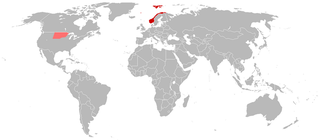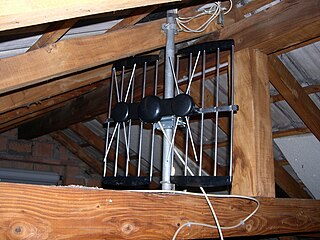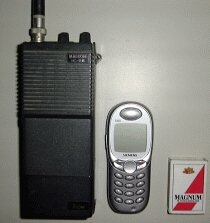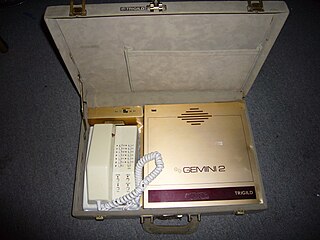OLT (Norwegian for Offentlig Landmobil Telefoni, Public Land Mobile Telephony), was the first land mobile telephone network in Norway. It was established December 1, 1966, and continued until it was obsoleted by NMT in 1990. In 1981, there were 30,000 mobile subscribers, which at the time made this network the largest in the world.

Norwegian is a North Germanic language spoken mainly in Norway, where it is the official language. Along with Swedish and Danish, Norwegian forms a dialect continuum of more or less mutually intelligible local and regional varieties, and some Norwegian and Swedish dialects, in particular, are very close. These Scandinavian languages, together with Faroese and Icelandic as well as some extinct languages, constitute the North Germanic languages. Faroese and Icelandic are hardly mutually intelligible with Norwegian in their spoken form because continental Scandinavian has diverged from them. While the two Germanic languages with the greatest numbers of speakers, English and German, have close similarities with Norwegian, neither is mutually intelligible with it. Norwegian is a descendant of Old Norse, the common language of the Germanic peoples living in Scandinavia during the Viking Era.

NMT is the first fully automatic cellular phone system. It was specified by Nordic telecommunications administrations (PTTs) and opened for service on 1 October 1981 as a response to the increasing congestion and heavy requirements of the manual mobile phone networks: ARP (150 MHz) in Finland, MTD (450 MHz) in Sweden and Denmark, and OLT in Norway.
The network operated in the 160 MHz VHF band, using frequency modulation (FM) on 160-162 MHz for the mobile unit, and 168-170 MHz for the base station. Most mobile sets were semi-duplex, but some of the more expensive units were full duplex. Each subscriber was assigned a five digit phone number.

In telecommunications and signal processing, frequency modulation (FM) is the encoding of information in a carrier wave by varying the instantaneous frequency of the wave.
In 1976, the OLT system was extended to include UHF bands, incorporating MTD, and allowing international roaming within Scandinavian countries.
MTD was a manual mobile phone system for the 450 MHz frequency band. It was introduced in 1971 in Sweden, and lasted until 1987, when it was made obsolete by the NMT automatic service. The MTD network had 20,000 users at its peak, with 700 people employed as phone operators.

Scandinavia is a region in Northern Europe, with strong historical, cultural, and linguistic ties. The term Scandinavia in local usage covers the three kingdoms of Denmark, Norway, and Sweden. The majority national languages of these three, belong to the Scandinavian dialect continuum, and are mutually intelligible North Germanic languages. In English usage, Scandinavia also sometimes refers to the Scandinavian Peninsula, or to the broader region including Finland and Iceland, which is always known locally as the Nordic countries.

Advanced Mobile Phone System (AMPS) was an analog mobile phone system standard developed by Bell Labs, and officially introduced in the Americas on October 13, 1983, Israel in 1986, Australia in 1987, Singapore in 1988, and Pakistan in 1990. It was the primary analog mobile phone system in North America through the 1980s and into the 2000s. As of February 18, 2008, carriers in the United States were no longer required to support AMPS and companies such as AT&T and Verizon Communications have discontinued this service permanently. AMPS was discontinued in Australia in September 2000, in Pakistan by October 2004,, in Israel by January 2010, and Brazil by 2010.

GSM is a standard developed by the European Telecommunications Standards Institute (ETSI) to describe the protocols for second-generation (2G) digital cellular networks used by mobile devices such as mobile phones and tablets. It was first deployed in Finland in December 1991. As of 2014, it has become the global standard for mobile communications – with over 90% market share, operating in over 193 countries and territories.
The Universal Mobile Telecommunications System (UMTS) is a third generation mobile cellular system for networks based on the GSM standard. Developed and maintained by the 3GPP, UMTS is a component of the International Telecommunications Union IMT-2000 standard set and compares with the CDMA2000 standard set for networks based on the competing cdmaOne technology. UMTS uses wideband code division multiple access (W-CDMA) radio access technology to offer greater spectral efficiency and bandwidth to mobile network operators.

Ultra high frequency (UHF) is the ITU designation for radio frequencies in the range between 300 megahertz (MHz) and 3 gigahertz (GHz), also known as the decimetre band as the wavelengths range from one meter to one tenth of a meter. Radio waves with frequencies above the UHF band fall into the super-high frequency (SHF) or microwave frequency range. Lower frequency signals fall into the VHF or lower bands. UHF radio waves propagate mainly by line of sight; they are blocked by hills and large buildings although the transmission through building walls is strong enough for indoor reception. They are used for television broadcasting, cell phones, satellite communication including GPS, personal radio services including Wi-Fi and Bluetooth, walkie-talkies, cordless phones, and numerous other applications.
Integrated Digital Enhanced Network (iDEN) is a mobile telecommunications technology, developed by Motorola, which provides its users the benefits of a trunked radio and a cellular telephone. It was called the first mobile social network by many technology industry analysts. iDEN places more users in a given spectral space, compared to analog cellular and two-way radio systems, by using speech compression and time division multiple access (TDMA).

A radiotelephone is a communications system for transmission of speech over radio. Radiotelephone systems are very rarely interconnected with the public switched telephone network, and in some radio services, including GMRS, such interconnection is prohibited. "Radiotelephony" means transmission of sound (audio) by radio, in contrast to radiotelegraphy or video transmission. Where a two-way radio system is arranged for speaking and listening at a mobile station, and where it can be interconnected to the public switched telephone system, the system can provide mobile telephone service.

Celcom Axiata Berhad, DBA Celcom, is the oldest mobile telecommunications provider in Malaysia. Celcom is a member of the Axiata group of companies. Being one of the very few companies in Malaysia to originally obtain a cellular phone license, it successfully introduced mobile telephony in Malaysia through its ART-900 service, using first generation (analogue) ETACS specifications of the United Kingdom, a derivative of the US-AMPS technology. The ETACS ART-900 was started using the prefix "010". Celcom now uses the dialling prefix identifier of "013" and "019" and offer digital GSM, an originally European standard, now largely a world standard for mobile communications. The original frequency band for GSM is 900 MHz, and was soon extended to 1800 MHz to cater for a much wider bandwidth requirements. The 2100 MHz band is used for their dual-channel HSPA+ network. Celcom is also licensed and has been operating FDD-LTE on 1800 MHz and 2600 MHz.
3G, short for third generation, is the third generation of wireless mobile telecommunications technology. It is the upgrade for 2G and 2.5G GPRS networks, for faster internet speed. This is based on a set of standards used for mobile devices and mobile telecommunications use services and networks that comply with the International Mobile Telecommunications-2000 (IMT-2000) specifications by the International Telecommunication Union. 3G finds application in wireless voice telephony, mobile Internet access, fixed wireless Internet access, video calls and mobile TV.

WiMAX is a family of wireless broadband communication standards based on the IEEE 802.16 set of standards, which provide multiple physical layer (PHY) and Media Access Control (MAC) options.

A cordless telephone or portable telephone is a telephone in which the handset is portable and communicates with the body of the phone by radio, instead of being attached by a cord. The base station is connected to the telephone network through a telephone line as a corded telephone is, and also serves as a charger to charge the handset's batteries. The range is limited, usually to the same building or some short distance from the base station.

The Improved Mobile Telephone Service (IMTS) was a pre-cellular VHF/UHF radio system that links to the PSTN. IMTS was the radiotelephone equivalent of land dial phone service. It was introduced in 1964 as a replacement to Mobile Telephone Service or MTS and improved on most MTS systems by offering direct-dial rather than connections through a live operator.

The history of mobile phones covers mobile communication devices that connect wirelessly to the public switched telephone network.
ARP was the first commercially operated public mobile phone network in Finland. The technology is zero-generation (0G), since although it had cells, moving between them was not seamless. The network was proposed in 1968 and building began in 1969. It was launched in 1971, and reached 100% geographic coverage in 1978 with 140 base stations. The ARP network was closed at the end of 2000 along with NMT-900.
B-Netz was an analog, commercial mobile radio telephone network that was operated by the Deutsche Bundespost in Germany from 1972 until 1994. The system was also implemented in neighboring countries Austria, The Netherlands and Luxembourg. The B refers to the fact that it was the country's second public mobile telephone network, following the A-Netz.

Free Mobile is a French wireless service provider, part of the Iliad group. It was the fourth mobile network operator to obtain a metropolitan French 3G license in 2009. It also obtained a 4G license in 2011.

The Japanese mobile phone industry is one of the most advanced in the world. As of July 31, 2013 there were 139,180,300 mobile phones in use in Japan. This is 110 percent of Japan's total population according to the Ministry of Internal Affairs and Communications.
The Altai mobile telephone system is the pre-cellular 0G radiotelephone service that was first introduced in the Soviet Union in 1963, and became available in the most large cities by 1965. It is a fully automated UHF/VHF network that allows a mobile node to connect to a landline phones, and was originally conceived to serve government officials and emergency services, but has since spread into general use, and is still in use in some places, where its advantages outweigh those of conventional cellular networks.
Work on the system of automatic duplex mobile communication started in 1958 in Voronezh Research Institute of Communications. It was established subscriber stations and base stations for communicating with them.
The Asia-Pacific Telecommunity (APT) band plan is a type of segmentation of the 698–806 MHz band formalized by the APT in 2008–2010 and specially configured for the deployment of mobile broadband technologies. This segmentation exists in two variants, FDD and TDD, that have been standardized by the 3rd Generation Partnership Project (3GPP) and recommended by the International Telecommunications Union (ITU) as segmentations A5 and A6, respectively. The APT band plan has been designed to enable the most efficient use of available spectrum. Therefore, this plan divides the band into contiguous blocks of frequencies that are as large as possible taking account of the need to avoid interference with services in other frequency bands. As the result, the TDD option includes 100 MHz of continuous spectrum, while the FDD option comprises two large blocks, one of 45 MHz for uplink transmission in the lower part of the band and the other also of 45 MHz for downlink transmission in the upper part. As defined in the standard, both FDD and TDD schemes for the 700 MHz band include guard bands of 5 MHz and 3 MHz at their lower and upper edges, respectively. The FDD version also includes a center gap of 10 MHz. The guardbands serve the purpose of mitigating interference with adjacent bands while the FDD center gap is required to avoid interference between uplink and downlink transmissions. The two arrangements are shown graphically in figures 1 and 2.














